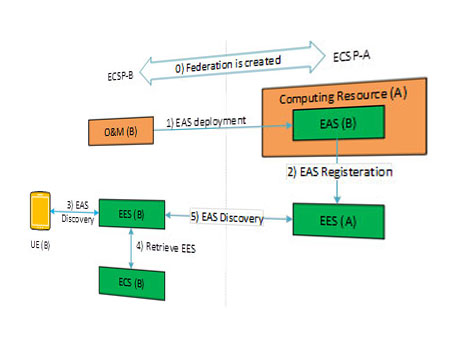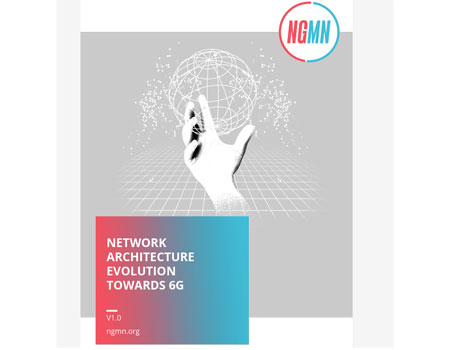By Sapan Shah (Samsung), Rapporteur EDGEAPP_Ph2 WID in 3GPP SA6.
With emergence of 5G Applications, data consumption is expected to increase by multiple folds compared to previous generation networks.
Certain 5G Applications have low latency as a KPI requirement. In order to reduce the latency, and thereby enhance the user experience, Edge computing is an essential feature, which brings the compute resources closer to the end users.
Edge computing is supported within 3GPP networks with the introduction of Edge computing capabilities in 5G System Architecture (3GPP TS 23.501 [1]). To further support the system architecture, 3GPP has also introduced the Edge Enabler Layer (EEL) in 3GPP TS 23.558 [2] in Rel-17, to enable applications to better utilize 3GPP Edge computing capabilities. The EEL defines capabilities to configure and deploy the applications at the edge and enables the User Equipment (UE) to discover and consume applications at the edge.

Figure-1: Edge Enabler Layer (Simplified)
Figure-1 shows a simplified version of the EEL specified in Rel-17. The EEL is composed of Edge Enabler Client (EEC), Edge Enabler Server (EES) and Edge Configuration Server (ECS). The EEL exposes APIs to support capabilities like service provisioning, registration, application server discovery, capability exposure to EAS and support for service continuity.
Using the capabilities provided by the EEL, the Application Clients (ACs) in the UE are able to locate and connect with the most suitable Edge Application Server (EAS) available in the Edge Data Network (EDN).
Rel-18 Enhancements
In Rel-18, several new features were introduced, such as Roaming, Federation and Edge Node Sharing, based on industry requirements from GSMA Operator Platform Group (OPG) [3]. These features are key to multi-operator scenarios and enabling interworking across multiple edge service providers.
3GPP SA6 WG developed a comprehensive study to evaluate the solutions associated to industry requirements, which are captured in 3GPP TR 23.700-98 [4]. Based on the study conclusions, the features are specified in the Rel-18 3GPP TS 23.558 [2].
Roaming and Federation
Roaming is a scenario where a UE is served by a visited PLMN (V-PLMN). It is possible to provide edge services to the roaming UEs if they can locally access the EAS hosted in the EDN of VPLMN.
To support UEs that are roaming, the EEL relies on ECSs available in both HPLMN and VPLMN. The EEC in the UE obtains EEL services from the ECS in visited PLMN (V-ECS) and EES from the visited PLMN (V-EES). EDGE-10 reference point is used for interaction between the H-ECS and the V-ECS. EDGE-4 reference point is used for interaction between EEC and V-ECS in V-PLMN, and between EEC and H-ECS in H-PLMN.
Two roaming models are supported for edge enabling applications:
- Local breakout (LBO) roaming architecture; when the LBO PDU Session is used for routing EDGE-4 traffic between the EEC and the H-ECS; and
- Home Routed (HR) roaming architecture; when the HR PDU Session is used for routing EDGE-4 traffic between the EEC and the H-ECS.

Figure-2: Architecture for roaming support (LBO and Home Routed)
Figure 2 shows the simplified architecture illustrating the EDGE-4 and EDGE-10 interface used for roaming. In the two roaming models, the EDN is located in the V-PLMN and is locally accessed via an LBO or HR session breakout (HR-SBO).
The federation of operators (as defined in GSMA OPG [3]) is a relation between two or more operators where one operator (called lead operator) exposes capabilities of the other operator (called partner operator) to 3rd party service providers or to their own subscribers.
The federation enables operators to make their assets and capabilities available across multiple networks. Federation is a scenario where UE is connected to its home PLMN but may use the edge services from the federated partner. The EDGE-4 and EDGE-9 interfaces as defined in Rel-17 and EDGE-10 interface defined in Rel-18 are used to support federation.
Further, in order to support roaming and federation capabilities, the ECS can be optionally enhanced to support repository functions, called ECS-ER, which is used in roaming and federation procedures. An Edge Computing Service Provider (ECSP) can have one or more ECSs enhanced to support repository functions. Here, the operator (i.e. PLMN provider) is also considered as an ECSP.
To enable UE to connect to EDN of the V-PLMN (in case of roaming) or partner PLMN (in case of federation), the ECS of home PLMN need to provide service provisioning information to the EEC residing in the UE. In order to share the service provisioning information to the partner PLMN, ECS profile has been defined which includes information about the ECS and EDN configuration.
The following new procedures are defined to support roaming and federation:
Edge Node Sharing (ENS)
One of the important services within federation is Edge Node Sharing (ENS). ENS is a scenario wherein partner Operator Platform (OP) shares the compute resource to lead OP. The lead OP deploys the application on the shared resource based on the application service provider’s requirements. Here, the operator providing the OP is also considered as an ECSP.
a. EAS discovery via leading ECSP: This procedure is applicable only for federation scenario. The EAS discovery procedure has been enhanced to enable EES to discover EAS from partner ECSP. This procedure is applicable when UE does not have direct access to the partner ECSP entities.

Figure 3: Edge node sharing scenario
Figure 3 provides details about the ENS scenario in federation. Here, ECSP-B is leading ECSP and ECSP-A is partner ECSP. The leading ECSP, when serving the requests originating from (its own) UEs, decides to provide the application from the Edge nodes of a partner ECSP (where the application is available).
b. EAS discovery via Partner ECSP: When the required credentials are available to communicate with partner ECSP, the EEC can use the EAS discovery procedures to directly obtain the EAS information from the EES of the partner ECSP.
3GPP also worked on alignment of EEL with GSMA operator platform (OP). As GSMA PRD [3] defines OP by providing the reference architecture, technical requirements, functional blocks and interfaces.
The OP focuses on to define edge computing exposure, integrating the network services to the Application Providers and enabling a simple and universal way of interacting towards edge computing platforms. The OP has mainly defined three roles - Capabilities Exposure Role, Service Resource Manager Role and Federation Broker and Federation Manager Roles.
As shown in Figure-4, the EES and ECS as defined in the EEL can be mapped to OP and their roles. Detailed mapping of interface with EEL can be found in 3GPP TR 23.958 [5].

Figure-4: Relationship between EDGEAPP architecture and GSMA OP reference architecture
Apart from the features described above, many other new features are specified in the Rel-18 3GPP TS 23.558, such as discovery of a common EAS, EAS synchronization, bundled EASs, dynamic EAS instantiation, enhancements to service continuity planning, application context relocation (ACR) between edge and cloud, EEL support for service differentiation, notification management service, Exposure of EAS Service APIs using CAPIF, EDGE-5 APIs, Application traffic filter exposure, Application traffic influence from EAS, Support of constrained devices, Support of NAT deployed within EDN, ACR scenario combination, Simultaneously EAS connectivity in ACR, Usage of Edge Analytics ...
Rel-18 enhancements for the EEL makes it more attractive for the ECSPs to deploy and provide more rich services to enable edge applications that can serve both the end user consumers and the industry verticals.
References:
[1] 3GPP TS 23.501 - System architecture for the 5G System (5GS)
[2] 3GPP TS 23.558 - Architecture for enabling Edge Applications
[3] GSMA PRD OPG.02 Operator Platform Telco Edge Requirements version 4.0
[4] 3GPP TR 23.700-98 - System architecture for the 5G System (5GS)
[5] 3GPP TR 23.958 - Edge Application Standards in 3GPP and Alignment with External Organizations


 Technology
Technology




